The future of trust and transparency in the food supply chain
- Like
- Digg
- Del
- Tumblr
- VKontakte
- Buffer
- Love This
- Odnoklassniki
- Meneame
- Blogger
- Amazon
- Yahoo Mail
- Gmail
- AOL
- Newsvine
- HackerNews
- Evernote
- MySpace
- Mail.ru
- Viadeo
- Line
- Comments
- Yummly
- SMS
- Viber
- Telegram
- Subscribe
- Skype
- Facebook Messenger
- Kakao
- LiveJournal
- Yammer
- Edgar
- Fintel
- Mix
- Instapaper
- Copy Link
Posted: 5 November 2021 | Bethan Grylls (New Food) | No comments yet
New Food’s Bethan Grylls speaks with three well-known food brands to hear how companies can transition to a totally transparent model and outlook.
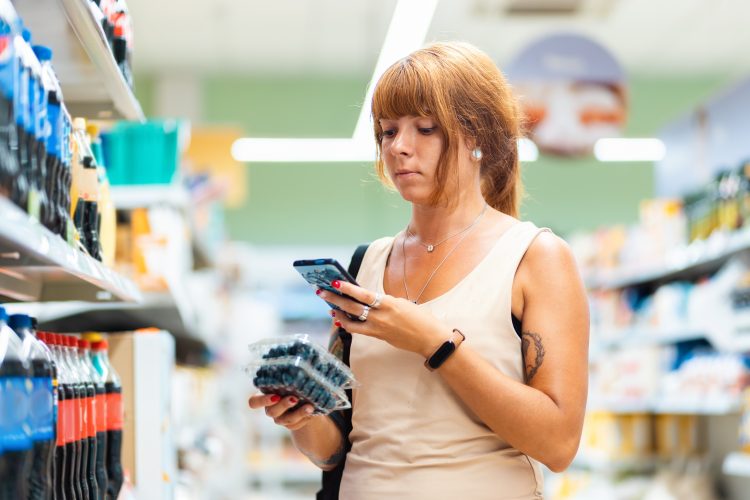

As demand for transparency rises, scanning QR codes in supermarkets may become commonplace
Globally, the food and beverage sector remains on shaky ground, according to a recent report from Edelman on trust. Following an increase in institutional trust between May 2020 and January 2021, consumers’ faith in the food and drink sector has plummeted.1
This is unsurprising considering the disquiet that’s been dominating the headlines in recent year – from Brexit and worker shortages, to food insecurity, climate change, GMOs, pesticides and antibiotic resistance.
Trust in food is declining
Among subsectors, brewing and spirits has been hit the worst, although it seems that makers of food additives are the least trusted by consumers overall. Despite also seeing a decline, farmers and fisheries remain the most trusted division of the food and drink chain.1,3
Trust in governments has seen particular deterioration, with 25 percent of countries not trusting their government to provide safe food, water or power. The most trusted nations include Singapore, The United Arab Emirates, Bahrain and the Philippines; while the least trusted include Yemen, Afghanistan, Lebanon and Iraq.2
The Edelman findings also revealed that consumers are expecting businesses to fill the void left by government and believe that CEOs should speak up on issues such as societal challenges, holding themselves accountable to the public as well as stakeholders. This ties in with the theme of food safety culture wherein leaders must demonstrate the behaviours they wish to be reflected across the entire company.
Meanwhile, the pandemic has accelerated the urgency to address foundational problems, including poverty, climate change, fake news and racism. The report from Edelman identified five system gaps, which the food and beverage sector should address; these include:
- An innovation gap – companies are prioritising product innovation over system innovation
- An inclusion gap – communities which are most in need of change are underrepresented
- An information gap – further transparency and information around sustainability and nutrition are required
- An incentive gap – growers have very little incentive to implement systems which could lessen environmental impact
- An investment gap – too little time is invested in bringing aboard the right people.
Trust in the UK
Interestingly, food from the UK is trusted far more than food from other countries, a survey from YouGov has found. This, it discovered, is especially true compared to food imported from the USA or China, where levels of trust are extremely low.4
“It is our [the UK’s] system of regulation and assurance schemes that means that while, according to the Centre for Disease Control and Prevention, 17 percent of people in the USA suffer from foodborne illnesses each year, that figure is just 1.5 percent in the UK,” Christine Tacon, Chair at Red Tractor (which commissioned the survey), noted within the report’s pages.
The results found that the UK public’s overall level of trust in British food is on par with its water quality and NHS care. However, while most agreed British food is safe, traceable and of good quality, trust in traceability lags behind. The report also identified an age gap, with a larger proportion of older respondents deeming food as traceable (84 percent of aged 65+) compared to younger people (67 percent of 18–39-year-olds).
The report reasons that this may be a result of older generations having lived through significant food crises before, including BSE and the foot-and-mouth disease outbreak, while younger people are more focused on authenticity.
“Consumers now want to understand what ingredients are going into their food and drink products, where they originate from, and whether they are ethically and sustainably sourced,” Paul Williams of international food and beverage company, Princes, told New Food.
Greater transparency will become critical
Indeed, this demand for greater accountability is one of the main drivers behind ‘radical’ or ‘total transparency’, an emerging mega trend which Mintel has highlighted as a “consumer watchword”, according to a report from Veris Strategies.5 This new level of transparency, the report predicts, will soon become business critical.
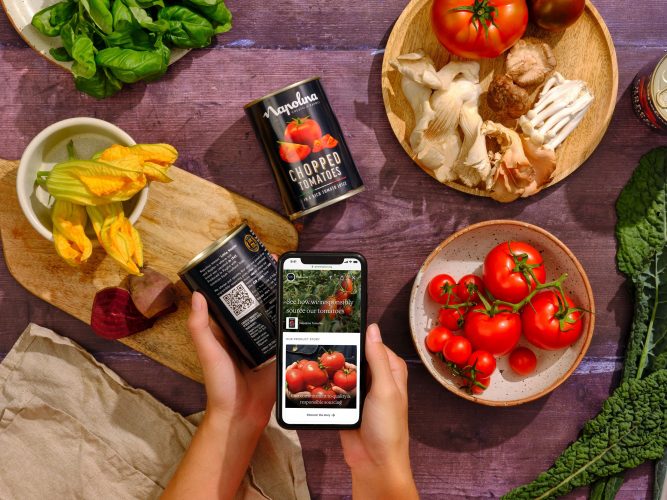

Through an initiative with Napolina, Princes has provided on-pack QR codes that consumers can scan to find out more information about their product
The idea of being totally transparent is new and will take time to adjust to. Two years ago, Princes took a step on this journey by updating its corporate vision to help families eat well “without costing the Earth”.
“We’re really trying to embed that in everything we do. In the 10 years I’ve been with Princes, we would never before have considered proactively sharing details of our supply chain in the public domain; it was just not the done thing. Of course, we offered a degree of transparency, but now we are proactively trying to share more information about our supply chain” Williams explained.
Using an analogy of a window into a restaurant kitchen, he continued: “If you’ve got nothing to hide, why wouldn’t you have windows into your kitchen? Customers don’t have to go up and stare, but there’s that ability to do so if they wanted. It’s about giving consumers that option.
“Through one of the initiatives with Napolina, we have provided on-pack QR codes that consumers can scan. This is powered by blockchain technology and offers details not just about where the products have been sourced from, but also the impact of those products on the planet and the workers.”
The company is working with an organisation called Provenance, which verifies the claims Princes makes on its products. “We feel that’s really important because there’s been examples in the past where companies say they are doing one really strong, fantastic thing – and then it’s discovered they’re greenwashing, there’s no tangible validation.”
Blockchain will certainly be a tech that gains in prominence with industry and consumers, due to its tamper-proof guarantees. According to Juniper Research, it will enable as much as 31 billion dollars-worth of food fraud to be saved globally within the next three years.6
Commenting on why total transparency is important, Jonathan Calland, Head of External Affairs at Tilda, told New Food: “Consumers have a lot of faith in household food brands – and in return, our job is to ensure we don’t let them down. Long-standing reputations are developed over years but can disappear in a heartbeat if you don’t stay on top of your game.”
What does total transparency mean?
Transparency means different things to different people, but the idea of total transparency is being “willing to share information” as Larry Lichter, VP, Global Quality and Food Safety from McCormick phrased it.
As mentioned earlier, there is significant focus on origin and authenticity when it comes to transparency, but the idea of total transparency is far deeper, encompassing an entrenched food safety culture and diverse integrity values.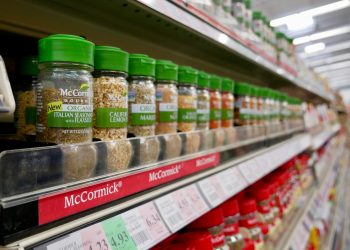

When asked what transparency should include, Tilda’s Calland listed authenticity but also aspects such as sustainability and welfare. “Delivering food products that are trusted and enjoyed by people all over the world is central to our business ethics. This covers everything from sustainable farming and production, through to packaging, on-pack claims and even delivery.
“At Tilda, we have set out our pledges to all areas of our business to ensure that we can function in the most efficient and trustworthy way possible.”
“The Institute of Customer Service said that environmental sustainability has become the most important influence in buying behaviour for 18 percent of UK consumers. That is going to grow, reaching 55 percent in the next five years. So this isn’t a ‘nice to do’ opportunity, it’s vital,” Williams confirmed.
Research suggests that consumers will expect companies to take more innovative and high-tech approaches to assuring and proving provenance5 and most likely the same will go for sustainability and welfare. Moreover, gaining access to such information shouldn’t consume time on the public’s part,5 it should be readily available.
Data will soon become king; the challenge will be presenting that information in a way that does not disinterest the consumer.5
Should transparency have a legal definition?
There is not a legal definition of transparency, although there are laws and regulations which mandate certain requirements of a food/drink company, which incorporate transparency. For example, in the UK, businesses must report their progress to identify and address modern slavery risks in their operations. While in the US state of California, there’s the Supply Chains Act which requires the same of companies.
Does the concept of total transparency require a more precise legal definition? The answer seems to be ‘no’, at least not for now.
“How would you define the requirements?” questioned Lichter. “Ultimately, if you overregulate and over specify, it may become more difficult to deploy than if you were to just let things develop and allow people to make active choices to leverage technology and insights.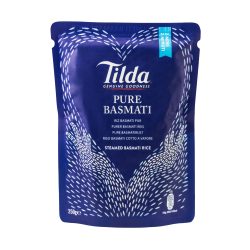

“This is a new space, right? So what would regulators use for the basis of their definitions? Some development and exploration is needed first.”
“The food sector is highly regulated, so any claims we make as a brand must be supported by evidence. There are also many different accredited bodies which independently regulate the industry verifying standards, but ultimately it is the company that must be responsible for how it operates day to day. So, I’m not sure how a legal definition of transparency would benefit the industry,” Calland remarked.
“At Tilda, we work closely with several non-governmental organisations that support recycling initiatives. The work that WRAP, the Flexible Plastic Fund and the On Pack Recycle Labelling (OPRL) are doing across the food and drink sector is tremendous. In practice, the voluntary sector can sometimes be more nimble…but regulation has a role too.”
Certification and validation
Certainly, the use of certifications can be a helpful tool. However, research suggests that due to the number of certification schemes and logos available, it can be confusing. Which? research found that if such labels were clearer and more meaningful, seven in 10 consumers would pay more attention to the environmental impact of the food they purchase.5
Third-party verification of food certification schemes is going to become more important in the future, as these will validate an on-pack logo’s credibility.5 In this way, collaboration will have a vital role to play.
Calland added: “Independent certification bodies are here to guide companies towards achieving food standards that exceed consumers’ expectations and can offer an independent verification service for any claims. But don’t forget, any food product must still deliver on taste. If it doesn’t meet people’s taste expectations and they don’t enjoy it, it will fail. As a company, we need to do the right thing, but how much consumers want to hear about varies enormously. Transparency is about trying to find the right balance.”
How can I be totally transparent?
There will be a variety of opportunities for means of collaboration in the future; not just for validation goals but also strategic relationships. One example, as outlined in the Veris Strategy report, is whole crop purchasing. Buyers and manufacturers can commit to buying the entire crop and redistribute any food that doesn’t meet specification to other parts of the supply chain.5
As mentioned earlier, data will also assume an important role. One such method of implementation is via live social feeds within retailers, so public feedback is immediate and readily available,5 helping consumers make informed choices in shop.
McCormick is currently investigating ways to deliver on total transparency and Lichter said the company’s work so far has centred around exploring the utility of a wide array of technologies. “We are exploring what’s possible and thinking about what insightswe can capture across the full spectrum of our supply chains.”
On collaboration, he said he considers it to be the key to many great efforts, but the way in which collaboration within transparency will form is yet to be determined.
Williams described the transition to total transparency as a journey and explained that sometimes difficult decisions have to be made when a supplier’s values are not aligned with your own brand. He also pointed to the varying levels within the supply chain and how each segment is integrated. “We don’t have the leverage over growers and cooperatives to say, ‘you must be more transparent and traceable’, so it’s about trying to sell the benefits to them.”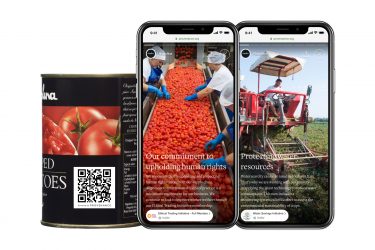

He added that creating change doesn’t happen overnight either. “In Italy we have a team of agronomists that visit a number of the farms we work with on a regular basis; here they engage with the workers and communities. If they see something that they’re not happy with or something that they feel could be improved, they then work with the associations, co-operatives and growers to influence that change. It isn’t something that is directly in our sphere of control, so it does take time.”
He continued: “Total transparency is an evolution and there is a nervousness; what’s the impact of sharing more information? Some may fear what consumers will be able to discover from being transparent. For us, it’s a case of bring it on – we have nothing to hide.”
Williams believes that those who are reluctant to become totally transparent will accept the change in time. He gave the example of when more stringent health and safety regulations came into force in the ’60s and ’70s. “Everyone was like ‘this is a real pain’, but now it’s the norm and has become embedded in the sector.”
For Tilda, a recent leap in transparency was the company’s first Impact Report.
“By launching the Tilda Impact Report 2021 and being honest and transparent about our challenges, I hope that we can encourage more businesses to consider their impact on the planet and people, whilst supporting our trade customers and consumers to play their part,” Calland noted.
Conclusion
Radical, total, or whatever name this new era of transparency may go by in the future, will demand transformative change5 including collaboration, smart technology and big data, as well as upskilling.
It’s not going to be an easy ride, but Williams reassures by reflecting that perfection is not necessary.
“If you can just demonstrate progression and the endeavour to improve over time, I think that’s also welcomed by consumers. You don’t have to be perfect and what you’ll probably find is that by being honest that you’re not perfect and by being open, you will receive more loyalty and more positive reception from consumers,” he reassured.
The concept of food safety culture has quickly become a buzzword in the sector – so will total transparency become the next big thing?
“I don’t know specifically,” answered Lichter honestly. “We believe in it. We believe that it’s an important area to explore and invest in, to help set the stage for the future. And we’ll see where it goes. We think there’s value there and we definitely want to go on that journey.”
References
- edelman.com/sites/g/files/aatuss191/files/2021-04/2021%20Edelman%20Trust%20Barometer%20Food%20%26%20Bev_Deck%20for%20edelman.com__0.pdf
- https://wrp.lrfoundation.org.uk/explore-the-poll/governments-in-25-per-cent-of-countries-are-not-trusted-to-provide-safe-food-water-and-power/
- newfoodmagazine.com/news/136260/food-trust-report/
- https://redtractor.org.uk/wp-content/uploads/2021/10/HL_UKTIFI_landscape_pr13_final-1.pdf
- Veris Strategies, 2018. Radical Transparency: The rise of disruptive consumerism
- newfoodmagazine.com/article/110116/blockchain/
Biographies


Jonathan Calland
Jonathan Calland is Head of Sustainability & External Affairs at Tilda Ltd and currently Chairman of the UK Rice Association. He has worked at the European Parliament in Brussels, and the Assemblée National in Paris, before specialising as a consultant on international trade policy for food industry associations. He studied in Belgium and the UK and holds a Masters in European Public Administration from the College of Europe in Bruges.


Larry Lichter
Larry Lichter is the VP, Global Quality and Food Safety for McCormick & Company, Inc. and currently serves as President of the American Spice Trade Association. In his current role at McCormick & Co., Mr. Lichter leads the company’s global efforts in food safety excellence, quality systems governance, quality and food safety technology development, analytical and microbiological sciences, food integrity and toxicology. During his nearly 32 years at McCormick, Larry has served in a variety of Quality and Supply Chain roles and prior to joining McCormick, worked for Baltimore Spice Company. He earned a Bachelors in Biology from the University of Virginia.


Paul Williams
Paul Williams is Group Head of Environmental and Social Sustainability (Supply Chains) at international food and drink group, Princes.
A Director of the Ethical Trading Initiative and Food Network for Ethical Trade, Paul’s role involves close engagement with like-minded companies, trade unions and voluntary organisations to promote respect for workers’ rights and improve environmental standards globally. He is an SA 8000 Social Systems Lead Auditor and holds a postgraduate degree from the University of Cambridge’s Institute for Sustainability Leadership.
Earlier in his career at Princes, Paul was European Senior Buyer for a number of food categories, ranging from Italian tomatoes to globally sourced tuna. Prior to joining Princes, Paul worked in commercial roles at Kellogg’s and Tesco, and has been a member of The Chartered Institute of Procurement & Supply (CIPS) since 2015.
Related topics
Labelling, Packaging & Labelling, Supply chain, Technology & Innovation, Traceability









